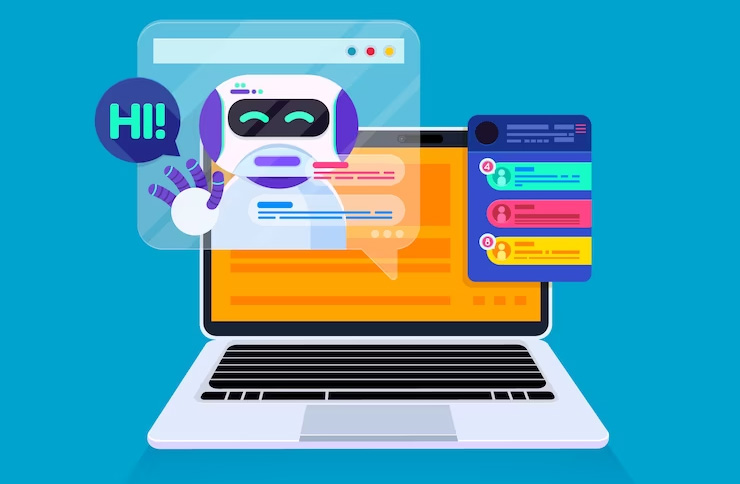With rapid advancements in artificial intelligence (AI) and machine learning, chatbots have emerged as game-changer in the digital marketing landscape. Businesses worldwide are now leveraging AI-powered chatbots to streamline customer interactions, boost engagement, and enhance their marketing efforts. In this blog post, we will explore the benefits of using AI-powered chatbots for digital marketing, and how you can implement them to stay ahead of the competition.

What Are AI-Powered Chatbots?
AI-powered chatbots are virtual assistants that use artificial intelligence and natural language processing to understand and respond to user queries in a human-like manner. These chatbots can be integrated into messaging platforms, websites, and mobile apps, providing instant, personalized responses to customer inquiries.
Why Use AI-Powered Chatbots in Digital Marketing?
Improved Customer Experience
AI-powered chatbots can handle multiple customer queries simultaneously, reducing response times and providing instant support. This enhances the customer experience, as users can quickly find answers to their questions without waiting for human assistance.
Cost-Effective Customer Support
By automating customer support tasks, chatbots can significantly reduce the cost of providing customer service. Companies can allocate their resources to other important aspects of their business, while chatbots handle routine queries and support requests.
Personalized Marketing
AI-powered chatbots can analyze customer data to deliver targeted marketing messages, product recommendations, and promotions. This personalized approach results in higher conversion rates and increased customer loyalty.
Implementing AI-Powered Chatbots in Your Digital Marketing Strategy
Define Your Chatbot’s Purpose
Before implementing a chatbot, it is crucial to define its purpose and establish its goals. Identify the specific tasks your chatbot will perform, such as answering frequently asked questions, providing product recommendations, or assisting with customer support.
Choose the Right Platform
Select a chatbot platform that aligns with your business needs and integrates seamlessly with your existing digital marketing tools. Some popular chatbot platforms include Dialogflow, Chatfuel, and Microsoft Bot Framework.
Design Conversational Flows
To create a user-friendly chatbot, design conversational flows that guide users through specific tasks or inquiries. Map out the possible user inputs and corresponding chatbot responses to ensure a smooth and intuitive interaction.
Train Your Chatbot
Leverage machine learning algorithms and natural language processing to train your chatbot to understand user queries and provide relevant responses. Continuously refine your chatbot’s performance by monitoring its interactions with users and making necessary adjustments.
Integrate Your Chatbot into Your Digital Marketing Channels
Incorporate your chatbot into various digital marketing channels, such as your website, social media platforms, and email marketing campaigns. This will help drive user engagement and maximize the benefits of your chatbot.
Measuring the Success of Your AI-Powered Chatbot
Monitor Key Metrics
Track key performance indicators (KPIs) to evaluate your chatbot’s success, such as user engagement, customer satisfaction, and conversion rates. Regularly analyze these metrics to identify areas for improvement.
Gather User Feedback
Solicit user feedback to gain insights into your chatbot’s strengths and weaknesses. Use this feedback to refine your chatbot’s performance and enhance the user experience.
Iterate and Optimize
Continuously iterate and optimize your chatbot to ensure it stays relevant and effective. Regularly update your chatbot’s knowledge base, and improve its conversion rate.
Conclusion
AI-powered chatbots have become an essential component of digital marketing strategies, providing businesses with a cost-effective and efficient way to enhance customer experience, improve support, and deliver personalized marketing messages. By carefully defining your chatbot’s purpose, choosing the right platform, designing conversational flows, and integrating it into your marketing channels, you can harness the power of AI to stay ahead of the competition. Remember to continually monitor your chatbot’s performance, gather user feedback, and optimize its functionality to ensure it remains an invaluable asset in your digital marketing arsenal. Embrace the future of marketing and let AI-powered chatbots propel your business to new heights.
Frequently Asked Questions (FAQ)
Q1: What is an AI-powered chatbot?
An AI-powered chatbot is a virtual assistant that uses artificial intelligence (AI) and natural language processing (NLP) to understand and respond to user queries in a human-like manner. These chatbots can be integrated into messaging platforms, websites, and mobile apps, providing instant and personalized responses to customer inquiries.
Q2: How do AI-powered chatbots improve digital marketing?
AI-powered chatbots can enhance digital marketing efforts by:
- Improving customer experience through instant, personalized support.
- Reducing customer support costs by automating routine tasks.
- Delivering targeted marketing messages and product recommendations based on user data.
Q3: How do I implement an AI-powered chatbot in my digital marketing strategy?
To implement an AI-powered chatbot in your digital marketing strategy:
- Define your chatbot’s purpose and goals.
- Choose a suitable chatbot platform.
- Design conversational flows for user interactions.
- Train your chatbot using machine learning algorithms and NLP.
- Integrate your chatbot into your digital marketing channels.
Q4: How do I measure the success of my AI-powered chatbot?
To measure the success of your AI-powered chatbot, monitor key performance indicators (KPIs) such as user engagement, customer satisfaction, and conversion rates. Additionally, gather user feedback and continuously iterate and optimize your chatbot to enhance its performance.
Q5: What are some popular AI-powered chatbot platforms?
Some popular AI-powered chatbot platforms include Dialogflow, Chatfuel, and Microsoft Bot Framework. Choose a platform that meets your business requirements and integrates seamlessly with your existing digital marketing tools.
GPT: The Future of Language Models and Their Impact on SEO
Image credit Freepik


